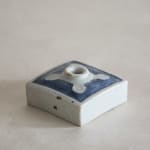


artisan's name unknown
oil jar, Mid 1770s - Late 1800s
Glazed ceramic
2 3/4" w x 2 3/4'' l x 1" h
Further images
The small jar is called Abura Tsubo (abura means oil, tsubo means jar). It is a container of oil, specifically of hair oil for ladies in mid to late Edo...
The small jar is called Abura Tsubo (abura means oil, tsubo means jar). It is a container of oil, specifically of hair oil for ladies in mid to late Edo period (1603 - 1868). The jar was only made in the Edo period when elaborate hairdos were common. When Edo ended, and the Japanese opened the country to the western world, women cut their hair and changed to a “modern” hairdo. Ladies no longer needed the oil; thus the jar was no longer produced.
It is fun to find an excellent work made for one specific fashion related purpose in a particular era. One can imagine the jar adorned by an elegant lady who had an outstanding still understated taste. An imagination goes to a wife of a high-ranking samurai.
It is fun to find an excellent work made for one specific fashion related purpose in a particular era. One can imagine the jar adorned by an elegant lady who had an outstanding still understated taste. An imagination goes to a wife of a high-ranking samurai.
Signup for our Newsletter
You will receive two emails a month from us. One introduces artworks and design works from Kyoto's hidden sources and the other is stories from Misako, sharing insights into Japanese culture.
* denotes required fields
为了回应您的查询,我们将根据我们的隐私政策处理您提供的个人数据。


